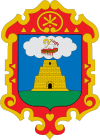Ayacucho
| Ayacucho Huamanga | |||
|---|---|---|---|
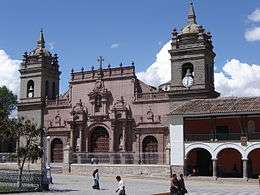  .jpg) .jpg) 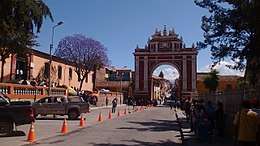 | |||
| |||
| Nickname(s): The City of Churches | |||
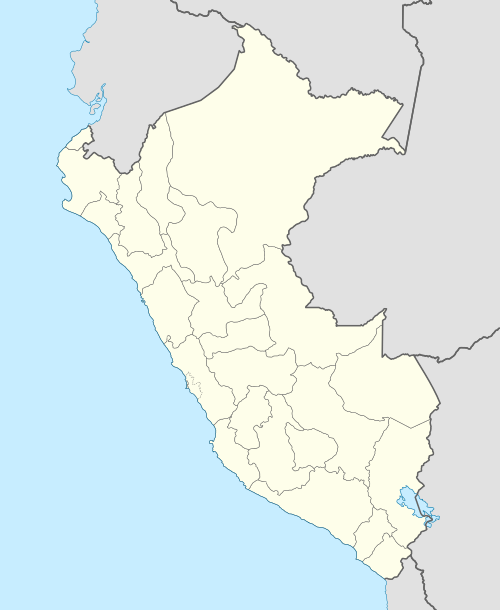 Ayacucho Location in Peru | |||
| Coordinates: 13°09′47″S 74°13′28″W / 13.16306°S 74.22444°W | |||
| Country | Peru | ||
| Region | Ayacucho | ||
| Province | Huamanga | ||
| Settled | April 25, 1540 | ||
| Government | |||
| • Mayor | Salomón Hugo Aedo Mendoza | ||
| Area | |||
| • Total | 2,981.37 km2 (1,151.11 sq mi) | ||
| Elevation | 2,761 m (9,058 ft) | ||
| Population (2014)[1] | |||
| • Total | 177,420 | ||
| • Density | 60/km2 (150/sq mi) | ||
| Demonym(s) | Ayacuchano, -1 | ||
| Time zone | UTC-5 (PET) | ||
| • Summer (DST) | UTC-5 (PET) | ||
| Area code(s) | 66 | ||
| Website | http://www.munihuamanga.gob.pe/ | ||
Ayacucho (Spanish pronunciation: [aʝaˈkutʃo], Quechua: Ayacuchu), is the capital city of Huamanga Province, Ayacucho Region, Peru.
Ayacucho is famous for its 33 churches, which represent one for each year of Jesus' life. Ayacucho has large religious celebrations, especially during the Holy Week of Easter. These celebrations include horse races featuring Peruvian Caballos de Paso and the traditional running of the bulls, known locally as the jalatoro or pascuatoro. The jalatoro is similar to the Spanish encierro, except that the bulls are led by horses of the Morochucos.
The name is derived from the Quechua words aya (death) and kuchu ("corner"), referring to a major battle for independence. Another possible interpretation is "soul or spirit corner," in reference to the great devotion of its people, even in pre-Hispanic times.
History
Vestiges of human settlements more than 15,000 years old have been found in the site of Pikimachay, about 25 km north of Ayacucho. From 500 to 900, the region became occupied by the Wari culture, which became known as the first expansionist empire based in the Andes before the Inca Empire.
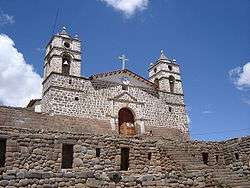
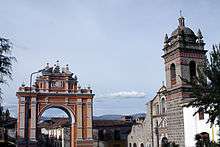


The Ayacucho region was inhabited by varying indigenous cultures for thousands of years, including the Wari, Chanka people, and Nazca culture before the Inca conquest.
The Spanish colonial founding of Ayacucho was led by conqueror Francisco Pizarro on April 25, 1540, who named it San Juan de la Frontera de Huamanga.[2] Due to the constant Incan rebellion led by Manco Inca Yupanqui against the Spanish in the zone, Pizarro was quick to populate the settlement with a small number of Spaniards brought from Lima and Cusco. On May 17, 1544, by Royal decree, Ayacucho was titled La Muy Noble y Leal Ciudad de Huamanga (the most noble and loyal city of Huamanga), the highest designation in the Spanish hierarchy of naming cities. The city's main University was founded on July 3, 1677 as San Cristóbal of Huamanga University. Ayacucho was significant in the colonial era for being an administrative center, a stopping-off point between Lima and Cuzco, and the residence of mercury miner from Huancavelica, as well as local land owners.[3]
On February 15, 1825, Simón Bolívar changed the city's name to Ayacucho, renaming it after the historical Battle of Ayacucho. Upon seeing so many casualties on the battlefield, citizens called the area Ayakuchu, aya meaning "dead" and kuchu meaning "corner" in Ayacucho Quechua. The Battle of Ayacucho was the last armed clash between Spanish armies and patriots during the Peruvian War of Independence, and the insurgents' victory ensured independence.[4] The battle developed in the nearby pampas of La Quinua on December 9, 1824. Independentist forces were led by Antonio José de Sucre, Simón Bolívar's lieutenant. Viceroy José de la Serna e Hinojosa was wounded, and after the battle second commander-in-chief José de Canterac signed the final capitulation of the Royalist army. The patriot victory sealed the independence of Peru and South America. La Paz, now the seat of government of Bolivia, was similarly renamed La Paz de Ayacucho following this battle.
Although the city gained a new name and some fame, the economy declined following independence. There were attempts to revive the city's fortunes, with a planned railway link to Peru's network, but the line was terminated in Huancavelica. A highway was subsequently constructed in 1968.[5] The city's economy is based on agriculture and light manufacturing, including textiles, pottery, leather goods, and filigree ware. It is a regional tourism destination, known for its 33 churches built in the colonial period, and for the nearby battlefield of La Quinua, where the Ayacucho battle was fought in 1824. The University of San Cristóbal was reopened in 1959. The city's population began to increase, but violent political unrest destabilized the region forced migration of many.[6]
In 1980, the insurgent organization known as the Shining Path (Sendero Luminoso) used Ayachucho as its base for its campaign against the Peruvian government, even staging an assault on the Ayacucho prison in 1982. The campaign faded after the leader Abimael Guzmán Reynoso was captured in 1992 and put in prison. The region headed by Ayacucho is rural and one of the poorest of all the country. With the peace of the last 15 years, the citizens work hard to improve the living conditions and attract jobs.
Notable people from Ayacucho
- María Parado de Bellido, heroine in War of Independence.[7]
- Efraín Morote Best, anthropologist and university president.
- Andrés Avelino Cáceres, President of Peru (1886–1890) and (1894–1895)
- Luis Guillermo Lumbreras, archaeologist.[8]
- Alberto Arca Parró, economist and lawyer.[9]
- Augusta la Torre, leader in the Sendero Luminoso movement.
- Raúl García Zárate, guitarist.[10]
See also
Coordinates: 13°09′47″S 74°13′28″W / 13.16306°S 74.22444°W
References
- ↑ Instituto Nacional de Estadística e Informática, Perfil Sociodemográfico del Perú Archived November 14, 2012, at the Wayback Machine. pp. 30.
- ↑ David Scott Palmer, "Ayacucho" in Encyclopedia of Latin American History and Culture, vol. 1, p. 245. New York: Charles Scribner's Sons 1996.
- ↑ Palmer, "Ayacucho", p. 245.
- ↑ Palmer, "Ayacucho", p. 245.
- ↑ Palmer, "Ayacucho", p. 245.
- ↑ Palmer, "Ayacucho", p. 245.
- ↑ Watson, Ian (October 11, 2002). Negotiating Cultures: Eugenio Barba and the Intercultural Debate. Manchester University Press. p. 207. ISBN 978-0719061707.
- ↑ Merino, Denis. "La importancia de la memoria". La Primera.
- ↑ "Alberto Arca Parró". University Honors & Awards. University of Indiana. Archived from the original on 2012-12-12. Retrieved 2012-08-23.
- ↑ "Guitarras Maestras". La Republica (in Spanish). 25 October 2009.
External links
| Wikisource has the text of the 1911 Encyclopædia Britannica article Ayacucho. |

